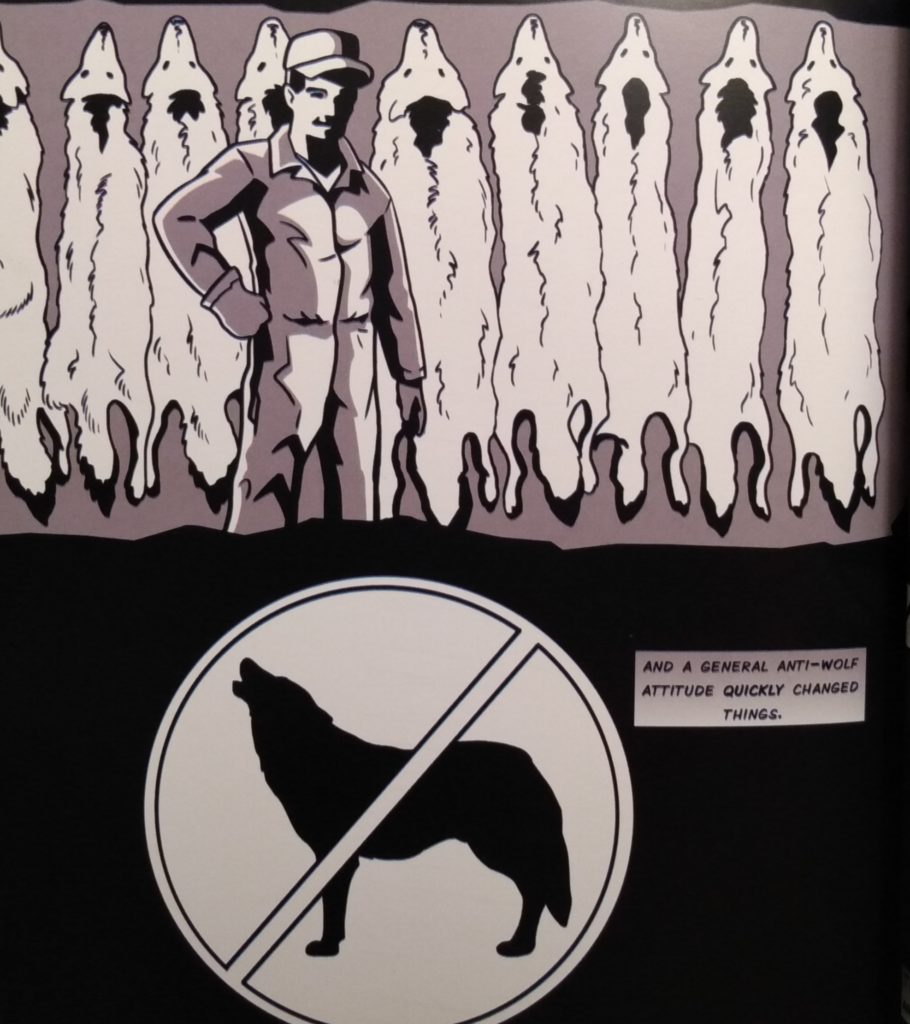“In less than ten years, wolves restored balance to a fragile ecosystem. Their return made Yellowstone a renewed pillar of conservation. But it was wolves like 42 and 21 that gave the reintroduction personality — and heart” — Howl: A New Look at the Big Bad Wolf, n. pag.
| Creator(s) | Ted Rechlin (author and illustrator) |
| Publisher | Farcountry Press |
| Publication Date | 2019 |
| Genre | Educational, Nonfiction |
| Environmental Themes and Issues | Animal Captivity, Animals in Danger, Conservation, Educational Nature Facts, Endangered Species, Extinction, Hunting, Poaching |
| Protagonist’s Identity | Recounts the stories of several notable wolves, both male and female (Nonhuman / Animal) |
| Protagonist’s Level of Environmental Agency | Level 4: Considerable Environmental Agency without Activism |
| Target Audience | Middle Grade (8-12 years) |
| Settings | Mexico, Yellowstone National Park, and California |

Environmental Themes
Howl: A New Look at the Big Bad Wolf educates readers about North American wolves, explicitly seeking to challenge long-lasting negative stereotypes about the animals that have led humans to harm them. Creator Ted Rechlin profiles three different real wolves, using these animals’ nonfictional stories to highlight the environmental issues that have impacted the species. First, the comic recounts the death of Lobo, a Mexican wolf who was killed by hunter Ernest Thompson Seton in in 1894 in New Mexico. Touched by Lobo’s defiance even after he was caught in a trap, Seton wrote a collection of short stories that portrayed himself as a villain and Lobo as a hero. The book inspired a conservation movement that aimed to preserve the Mexican wolf, though this early activism was not enough to save the species from near-extinction. In the 1980s, however, the U.S. and Mexico worked together to create the Mexican Wolf Recovery Plan, and, as of the comic’s publication in 2019, over 140 Mexican wolves exist in the wild in the Southwest U.S.

Next, the comic narrates the life and death of 21 and 42, two wild gray wolves that led the Druid Pack in Yellowstone National Park. Rechlin emphasizes the pivotal role that the wolves play in the ecosystem, noting that the reintroduction of the species “made the Yellowstone ecosystem whole again” by reducing the elk population (n. pag.). Fewer elk allowed the vegetation to rebound, leading to a resurgence in antelopes, bears, beavers, and birds of prey. The wolves also attracted more tourists to Yellowstone, bolstering the local economy. Though both wolves died of natural causes in 2004, their bloodlines live on in the Yellowstone packs, which have also spread to Oregon and California.

Throughout the comic, Rechlin highlights the various ways that humans have harmed wolves, including destroying their habitats, hunting and trapping them, and shooting them in an attempt to protect livestock. However, the comic also spotlights how humans have attempted to help wolves by passing protective legislation, such as the Endangered Species Act, and working to restore wolf populations in the Southwest and in Yellowstone. Finally, the comic critiques predominant myths about wolves that characterize the animals as frightening and violent. Rechlin encourages readers to adopt a more accepting view of wolves, writing, “Slowly but surely, wolves are on the move–returning to homes they haven’t known for generations. The truth about wolves is this: They are not mythical. They are not good or bad. They are animals, trying to live their lives–just like us. And whether or not they have place in this modern world is up to us” (Rechlin, n. pag.). However, while the comic does educate readers about wolves and counter myths about them, Rechlin does not suggest tangible ways that the audience could help the animals, such as donating to environmental organizations that protect wolf populations or writing to legislators.
Other environmental middle-grade comics created by Rechlin include Bears and Lions and Tigers.



